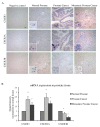Altered CXCR3 isoform expression regulates prostate cancer cell migration and invasion
- PMID: 22236567
- PMCID: PMC3320557
- DOI: 10.1186/1476-4598-11-3
Altered CXCR3 isoform expression regulates prostate cancer cell migration and invasion
Abstract
Background: Carcinoma cells must circumvent the normally suppressive signals to disseminate. While often considered 'stop' signals for adherent cells, CXCR3-binding chemokines have recently been correlated positively with cancer progression though the molecular basis remains unclear.
Results: Here, we examined the expression and function of two CXCR3 variants in human prostate cancer biopsies and cell lines. Globally, both CXCR3 mRNA and protein were elevated in localized and metastatic human cancer biopsies compared to normal. Additionally, CXCR3A mRNA level was upregulated while CXCR3B mRNA was downregulated in these prostate cancer specimens. In contrast to normal prostate epithelial cells (RWPE-1), CXCR3A was up to half the receptor in the invasive and metastatic DU-145 and PC-3 prostate cancer cells, but not in the localized LNCaP cells. Instead of inhibiting cell migration as in RWPE-1 cells, the CXCR3 ligands CXCL4/PF4 and CXCL10/IP10 promoted cell motility and invasiveness in both DU-145 and PC-3 cells via PLCβ3 and μ-calpain activation. CXCR3-mediated diminution of cell motility in RWPE-1 cells is likely a result of cAMP upregulation and m-calpain inhibition via CXCR3B signal transduction. Interestingly, overexpression of CXCR3B in DU-145 cells decreased cell movement and invasion.
Conclusion: These data suggest that the aberrant expression of CXCR3A and down-regulation of CXCR3B may switch a progression "stop" to a "go" signal to promote prostate tumor metastasis via stimulating cell migration and invasion.
Figures







Similar articles
-
Potential role of CXCR3 in proliferation and invasion of prostate cancer cells.Int J Clin Exp Pathol. 2015 Jul 1;8(7):8091-8. eCollection 2015. Int J Clin Exp Pathol. 2015. PMID: 26339376 Free PMC article.
-
Disparate roles of CXCR3A and CXCR3B in regulating progressive properties of colorectal cancer cells.Mol Carcinog. 2019 Feb;58(2):171-184. doi: 10.1002/mc.22917. Epub 2018 Oct 9. Mol Carcinog. 2019. PMID: 30302818
-
CXCR3A contributes to the invasion and metastasis of gastric cancer cells.Oncol Rep. 2016 Sep;36(3):1686-92. doi: 10.3892/or.2016.4953. Epub 2016 Jul 19. Oncol Rep. 2016. PMID: 27461521
-
CXCR3 in carcinoma progression.Histol Histopathol. 2015 Jul;30(7):781-92. doi: 10.14670/HH-11-594. Epub 2015 Feb 9. Histol Histopathol. 2015. PMID: 25663474 Free PMC article. Review.
-
CXCR3 ligands in disease and therapy.Cytokine Growth Factor Rev. 2015 Jun;26(3):311-27. doi: 10.1016/j.cytogfr.2014.11.009. Epub 2014 Nov 22. Cytokine Growth Factor Rev. 2015. PMID: 25498524 Review.
Cited by
-
Overview of the Mechanisms that May Contribute to the Non-Redundant Activities of Interferon-Inducible CXC Chemokine Receptor 3 Ligands.Front Immunol. 2018 Jan 15;8:1970. doi: 10.3389/fimmu.2017.01970. eCollection 2017. Front Immunol. 2018. PMID: 29379506 Free PMC article. Review.
-
C-X-C ligand 10 and C-X-C receptor 3 status can predict tamoxifen treatment response in breast cancer patients.Breast Cancer Res Treat. 2014 May;145(1):73-82. doi: 10.1007/s10549-014-2933-7. Epub 2014 Apr 9. Breast Cancer Res Treat. 2014. PMID: 24715380 Free PMC article. Clinical Trial.
-
The role of proinflammatory cytokines and CXC chemokines (CXCL1-CXCL16) in the progression of prostate cancer: insights on their therapeutic management.Cell Mol Biol Lett. 2024 May 14;29(1):73. doi: 10.1186/s11658-024-00591-9. Cell Mol Biol Lett. 2024. PMID: 38745115 Free PMC article. Review.
-
CXCL11 Expression by Keratinocytes Occurs Transiently Between Reaching Confluence and Cellular Compaction.Adv Wound Care (New Rochelle). 2016 Dec 1;5(12):517-526. doi: 10.1089/wound.2015.0680. Adv Wound Care (New Rochelle). 2016. PMID: 28078185 Free PMC article.
-
Chemokine receptor CXCR3 deficiency exacerbates murine autoimmune cholangitis by promoting pathogenic CD8+ T cell activation.J Autoimmun. 2017 Mar;78:19-28. doi: 10.1016/j.jaut.2016.12.012. Epub 2017 Jan 24. J Autoimmun. 2017. PMID: 28129932 Free PMC article.
References
Publication types
MeSH terms
Substances
Grants and funding
LinkOut - more resources
Full Text Sources
Other Literature Sources
Medical
Research Materials
Miscellaneous

